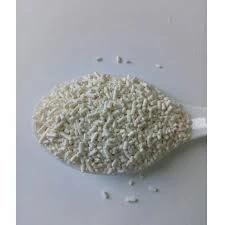
Understanding Acidity Regulators E330 and E331 in Food Applications and Their Effects
Understanding Acidity Regulators E330 and E331
In the realm of food additives, acidity regulators play a crucial role in enhancing the flavor, preserving freshness, and maintaining the stability of food products. Among these regulators, E330 (citric acid) and E331 (sodium citrate) are two widely used components that deserve special attention for their multifunctional properties and applications in the food industry.
What Are Acidity Regulators?
Acidity regulators are substances added to food to control its pH level. They help maintain the desired acidity or alkalinity that ensures the food is not only palatable but also safe from spoilage. The pH level can influence the texture, flavor, and preservation of food. Different acidity regulators serve various purposes, such as enhancing taste, preventing spoilage, and retaining color.
E330 - Citric Acid
E330, commonly known as citric acid, is a weak organic acid that naturally occurs in citrus fruits. It is recognized for its sour taste and is widely used in food and beverages to provide a refreshing tang. Citric acid serves numerous functions
1. Flavor Enhancement Citric acid is widely appreciated for improving the flavor profile of various products. It brightens the taste of beverages, candies, and sauces, making them more appealing to consumers.
2. Preservative Properties Due to its ability to lower the pH of foods, citric acid can inhibit the growth of bacteria and molds, thus extending shelf life and preventing spoilage. This makes it particularly valuable in products like jams, jellies, and fruit juices.
3. Antioxidant Citric acid can help to stabilize the quality of food products by acting as an antioxidant, which prevents oxidation and maintains the vibrant colors of fruits and vegetables.
acidity regulator 330 331

4. Emulsifying Agent In certain applications, citric acid serves as an emulsifying agent, helping to blend oil and water in products like salad dressings and sauces, ensuring a uniform texture.
E331 - Sodium Citrate
E331, or sodium citrate, is a sodium salt of citric acid. It is another valuable acidity regulator with unique properties that contribute to food processing and preservation. Here are some significant functions of sodium citrate
1. pH Control Sodium citrate acts as a buffering agent that helps maintain a stable pH level in food products. This is crucial for products that require a specific acidity for optimal taste and safety.
2. Food Stabilizer In dairy products like cheese and yogurt, sodium citrate is used to enhance texture and prevent curdling. It helps to create a smooth and creamy consistency, making it a popular ingredient in processed cheese products.
3. Carbonation Enhancer Sodium citrate is often used in the production of carbonated beverages. It helps stabilize carbon dioxide, creating a more effervescent product and enhancing the overall drinking experience.
4. Electrolyte Source Beyond its role in food, sodium citrate has applications in sports drinks and electrolyte solutions, providing essential minerals that help maintain hydration and energy levels.
Conclusion
Acidity regulators such as E330 (citric acid) and E331 (sodium citrate) play vital roles in modern food production. Their multifunctional properties not only enhance flavor but also contribute to food preservation, texture, and stability. As consumers become more health-conscious and discerning about food quality, understanding the roles of these additives can lead to better choices in our diets. While many people enjoy the tangy flavors of their favorite snacks and beverages, they may not realize the science and technology behind the ingredients that make these products both delicious and safe to consume. The continued research and development of acidity regulators will undoubtedly play an important part in the future of the food industry, paving the way for innovative solutions that satisfy consumer demands while ensuring food safety and quality.
-
Pure Sodium Dichloroisocyanurate Dihydrate | Powerful DisinfectantNewsAug.29,2025
-
Industrial Chemicals: Quality & Purity for Every IndustryNewsAug.28,2025
-
Nitrile Rubber Honoring Strict Production StandardsNewsAug.22,2025
-
Aspartame Ingredients Honoring Food Safety ValuesNewsAug.22,2025
-
Fertilizer for Balanced Plant NutritionNewsAug.22,2025
-
Cyanide Gold Processing with High Purity AdditivesNewsAug.22,2025
-
Formic Acid in Textile Dyeing ApplicationsNewsAug.22,2025
Hebei Tenger Chemical Technology Co., Ltd. focuses on the chemical industry and is committed to the export service of chemical raw materials.
-

view more DiethanolisopropanolamineIn the ever-growing field of chemical solutions, diethanolisopropanolamine (DEIPA) stands out as a versatile and important compound. Due to its unique chemical structure and properties, DEIPA is of interest to various industries including construction, personal care, and agriculture. -

view more TriisopropanolamineTriisopropanolamine (TIPA) alkanol amine substance, is a kind of alcohol amine compound with amino and alcohol hydroxyl, and because of its molecules contains both amino and hydroxyl. -

view more Tetramethyl Thiuram DisulfideTetramethyl thiuram disulfide, also known as TMTD, is a white to light-yellow powder with a distinct sulfur-like odor. It is soluble in organic solvents such as benzene, acetone, and ethyl acetate, making it highly versatile for use in different formulations. TMTD is known for its excellent vulcanization acceleration properties, which makes it a key ingredient in the production of rubber products. Additionally, it acts as an effective fungicide and bactericide, making it valuable in agricultural applications. Its high purity and stability ensure consistent performance, making it a preferred choice for manufacturers across various industries.





